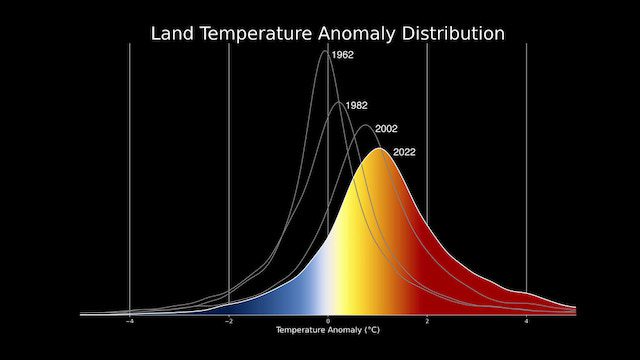Recent media reports talk of the probability of breaching the dreaded 1.5. Global atmospheric temperatures will likely reach 1.5 degrees Celsius above preindustrial levels by 2028.
The World Meteorological Organization (WMO) dropped its Global Annual to Decadal Climate Update recently, estimating a 66 percent chance that global temperatures will overtake the 1.5-degree limit within the next five years. A powerful El Niño combined with the relentless rise of heat-trapping gasses in the atmosphere means a continued trend of heat records falling one after another across the globe as the 1.5-degree target codified in the 2015 Paris Agreement edges closer.
The WMO’s report also forecasts a 98 percent chance that one of the next five years will be the hottest on record.
The Steady Rise Toward 1.5
It is important to note that the near-term likelihood of breaching 1.5 degrees Celsius this decade is only temporary. The WMO projects only a 32 percent chance of global average temperatures maintaining 1.5 degrees in the next five years. Nonetheless, in 2015, when 191 nations adopted the Paris Agreement, the odds of global temperatures flirting with the 1.5 threshold were next to zero. Between 2017 and 2021, those odds rose to 10 percent. The global average temperature in 2022 was 1.15 degrees C above the 1850-1900 average, despite the cooling effects of La Niña.
Climate change is a study of probabilities and trends. Conditions naturally fluctuate through the days, weeks, months, and years. A classic bell curve distribution pattern shows the probability shift driving an accelerating trend toward a warmer global climate.
The following NASA “Land Temperature Anomaly Distribution” data image shows the rise in land temperatures between 1950 and 2020. The visualization shows that “as land temperatures have increased since 1950, hotter days have become more common, and colder days have become less common,” according to NASA.

Urgency at Last?
There is and should be much hand-wringing about the lack of action as the world lurches headlong into the guardrails we’ve talked about for decades. But if we don’t learn the lessons our climate inaction can teach us, all the agitation is for naught.
The days of pining for a clean transition from late-stage capitalism into a “climate-friendly” economy are long gone. That’s good news. At least as good as it gets.
Let me explain:
Someone once told me way back in 2009, shortly before the UN COP 15 climate conference, that meaningful climate change awareness, let alone action-at-scale, would not happen until the water laps at our feet. Or the smoke clouds the horizon. Or the parched river runs dry.
If there was room for equivocation in 2009, there is little room for it now. An article in CarbonBrief reveals that over the past decade, half of the world’s population has experienced record heat compared to the 1950 average. The smoke is on the horizon, and the abstract “1.5” comes sharper into focus.
Starting From Where We Are
So that’s it, then. Time to act! Time to do something. For most of us, climate change is real. The rains don’t come, or they come too much and too fast. The seasons feel out of balance. The knock-on consequences of this imbalance manifest in unexpected ways. We have stepped through the door of a new climate regime.
Despite the persistent cast of doubters and misinformers, we feel it in our bones, a growing sense of urgency to step up to the climate challenge.
This may be little comfort to the generations inheriting the back end of this century. The wasted time is impossible to excuse. I offer none, only to say that we must start from where we are now.
Photo by Dikaseva on Unsplash


